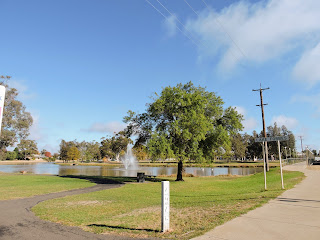------
Majdnem hat hónap telt el a legutóbbi túránk óta, és már régen nagyon mehetnékünk volt megint. De eddig nem tudtunk elmenni több okból, és most is csak egy rövid útra van időnk. Először azt terveztük, hogy felmegyünk Tumut-ba és a Havas Hegység északi részében kalandozunk egy hétig. De mikor megnéztük az időjárás előrejelzést, kiderült, hogy ez most nem nekünk való: éjszaka nulla fok körül, és nappal is csak 10 fok körüli maximum várható. Újabb tervünk a Central West régió, ahol eddig még nem jártünk. Ugyan az éjszakák ott is majdnem olyan hidegek, de nappal legalább 18-19 fokot várhatunk napsütéssel. Tehát szabad kempingezés most nem jöhet szóba, az éjszakákat kempingben kell töltenünk, ahol be tudjuk fűteni a lakókocsit a kis elektromos fűtőtestünkkel.
Hétfőn, május 14-én indultunk Sydney-ből, szép napos meleg időben. A Kék Hegyeken keresztül vezetett az utunk. Ahogy feljebb értünk, majd lefelé a mások oldalon, szép látvány volt a sok őszi színpompás európai fa az út két oldalán.
 |
| Legelésző birkanyájak az út mentén |
Egy rövid ebéd-pihenő után, délután 4 óra felé értünk Canowindra-ba, első állomáshelyünkre, még szép meleg napos időben. Mire letelepedtünk egy jó kis kempingben a város szélén, és egy forró zuhannyal felfrissítettük magunkat, lement a nap és lehűlt az idő. A napok elég rövidek itt már májusban, öt óra felé sötétedik. Jól esett a fűtött lakókocsiban melegedni.
Másnap reggel 6-kor 4 fok volt a lakókocsiban - éjszakára ki szoktuk kapcsolni a fűtést és jól felöltözünk a hálózsákban hogy ne fázzunk. Aztán bekapcsoljuk a fűtést fél órával felkelés előtt, és hamarosan a nap is feljön és segít felmelegíteni a levegőt.
 |
| Nangar nemzeti park |
Reggeli után benéztünk a turista irodába egy kis helyi információért, aztán elmentünk a közeli Nangar Nemzeti Parkba. Ez egy viszonylag kis hegyes-völgyes park, sík legelős vidékkel körülvéve. Sok birkát és néhány tehent láttunk legelészni a földeken. Egy keskeny földút vezet a parkba, mellette egy felhagyott tanya romjai. Szomorú látvány: száz évvel ezelőtt egy család itt próbált életet teremteni magának, sikertelenül. Egy száraz patakmeder mellett vezetett az út tovább meredek sziklás erdős hegyoldalak között, míg elértünk a park egyik fő látványosságához, úgy hívják hogy Dripping Rock (csepegő szikla). Egy lapos sziklaorom a völgy oldalában, ahol esős idő után a víz még sokáig csepeg lefelé a szikla függőleges erodált felületén. Most éppen nem csöpögött, de a szikla érdekes volt, az idő szép napos és meleg. Megebédeltünk a szikla melletti piknik helyen és még nézelődtünk egy kicsit. Láttunk két sast körözni a levegőben, elég sokáig figyeltük őket de nem jöttek elég közel hogy fénykéezni lehessen.
 |
| A "Csepegő szikla" |
A másik látványosság egy kilátó lett volna a Mount Nangar 770 m magas tetejéről, de ahhoz még 15 km-t kellett volna autózni a hepehupás földúton, amiről inkább lemondtunk.
 Visszafelé Eugowra felé jöttünk, útközben megálltunk a legnagyobb fegyveres aranyrablás helyszínén. 1862-ben egy rablóbanda feltartóztatott itt egy rendőrökkel kísért aranyszállító kocsit. A rendőrök elmenekültek, a rablók mintegy 5 millió dollár értékű aranyat zsákmányoltak. Egy emléktábla és leírás jelzi a helyet ahol az eset történt egy nagy szikla mellett amit most Escort Rock-nak hívnak.
Visszafelé Eugowra felé jöttünk, útközben megálltunk a legnagyobb fegyveres aranyrablás helyszínén. 1862-ben egy rablóbanda feltartóztatott itt egy rendőrökkel kísért aranyszállító kocsit. A rendőrök elmenekültek, a rablók mintegy 5 millió dollár értékű aranyat zsákmányoltak. Egy emléktábla és leírás jelzi a helyet ahol az eset történt egy nagy szikla mellett amit most Escort Rock-nak hívnak.
Délután Canowindra-ban a városka régi főutcáján sétáltunk. Az egész utca műemlékileg védett terület, régi házak mindkét oldalon, vendégházak, fogadók, kocsmák, régi üzletek, néhány kávéház, de nem sok élet van bennük. A város 1820 körül keletkezett ahogy újabb telepesek érkeztek a Belubula folyó művelhető földjeit birtokba venni. A vasút 1910-ben ért ide, és gyors fejlődést hozott magával. De 1980-ban felszámolták a vasutat, és most a kétezer lakosú városka új funkciót próbál találni mint a térség kiszolgáló és turisztikai központja.
 |
| Canowindra a kilátóból |
Eredetileg két éjszakát akartunk itt maradni, de a kempingben azt hallottuk, hogy két éjszaka után a harmadik ingyen van, úgyhogy kihasználtuk ezt a lehetőséget. Szerdán, egy újabb szép tiszta napos délelőtt, felmentünk a Blue Jacket kilátóhoz, mindjárt a város mellett Keletre. Valóban szép látvány volt körbe-körbe, és a kivezető út melletti színpompás fasor is jól nézett ki.
Aztán megnéztük a város fő nevezetességét: a "Halak Kora" múzeumot, ami a régi vasutállomás helyén épült. 1956-ban egy közeli útépítés során egy hatalmas fosszil leletet találtak, majd 1993-ban egy régészeti feltárás gyarapította a gyűjteményt. Halak és egyéb vizi élőlények ezreit találták kőbe szilárdulva. Rég kihalt fajtákat, halakat kívül csontos páncéllal, másokat tüdővel, hatalmas ragadozókat krokodil-szerű fogazattal, sok közülük még ismeretlen fajta. A gyűjtemény egy része itt van kiállítva.
 |
| A fosszil múzeum |
A lelet a Devoni korszakból származik, 360 millió évvel ezelőtt, mikor az összes gerinces állatfaj vízben élt. Egy nagy édesvizű tó volt akkor itt, ami valami miatt hirtelen kiszáradt, és az összes benne élő állatok egyszerre elpusztultak. A kiszáradt tavat betemette a homok és a tetemek lassan megkövesedtek. A múzeumban jónéhány kőtábla van kiállítva amiben halak és hasonló élőlények lenyomata látható. Rengeteg érdekes információ is van arról a földtörténeti korszakról. Nagyon jól rendezett kis múzeum, érdemes volt megnézni.
 |
| Egy új halfajta: Mandageria fairfaxi |
Délután még sétáltunk egyet a Belubula folyó árterületén és a város másik részeiben. Aztán sötétedéskor megint bebújtunk a jó meleg lakókocsinkba.




























































